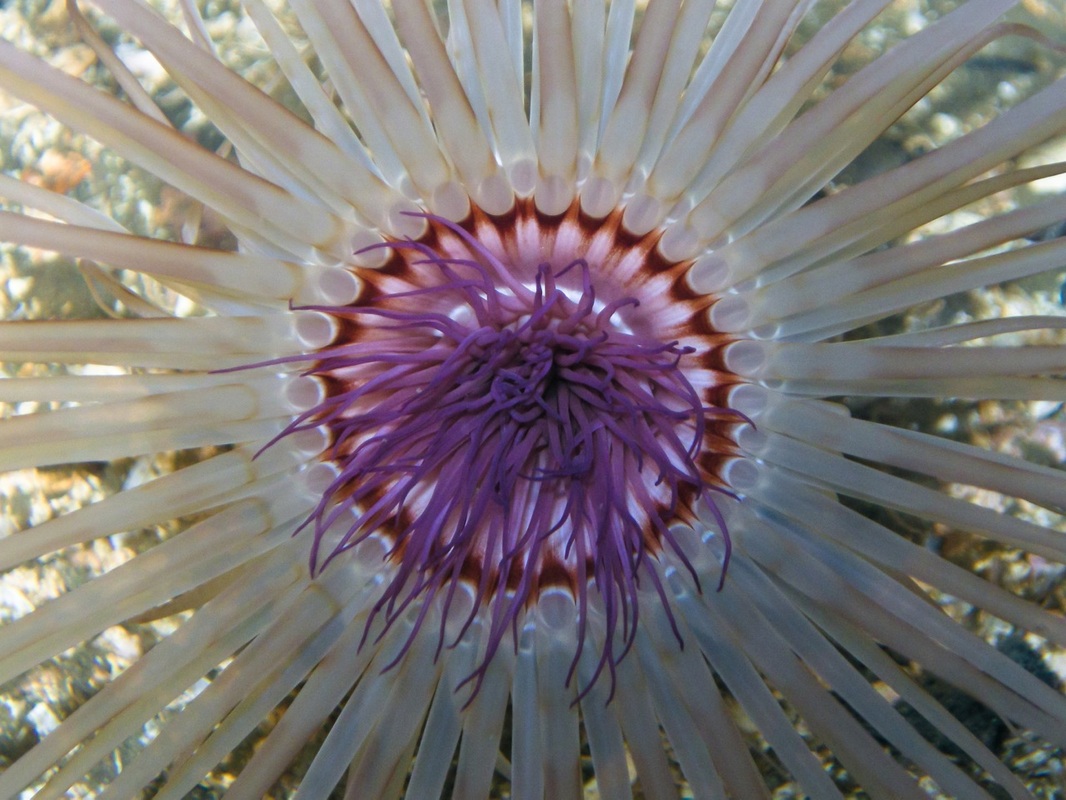Tube-dwelling anemone, tube anemone • Pachycerianthus fimbriatus

The tube-dwelling anemone's two sets of tentacles are visible at this angle looking straight down. Photo by Mike Munroe
Identification
The tube-dwelling anemone has an outer set of of long, delicate tentacles encircling a shorter inner set that hides the mouth. Tentacles vary in colour from light to purplish-black, and may be banded. The rest of the anemone is hidden from view, in a mostly buried black leathery tube made from material secreted by the anemone. The tube can be up to a meter in length and 2.5 cm in diameter; the animal gets to 35 cm long with a tentacle diameter of 20 cm.
Habitat & Range
The tube-dwelling anemone can be found in soft, level substrates in the subtidal (to 30 m deep) and occasionally the intertidal. Individuals may form extensive flower-like fields. Its range extends from southern Alaska to southern California.
Intriguing
This anemone is preyed up on by the giant nudibranch (Dendronotus iris) ; the nudibranch may also attach its egg masses to the anemone's tube. The anemone is capable of retracting into the its when disturbed or under attack.
iNaturalist
https://www.inaturalist.org/taxa/47702-Pachycerianthus-fimbriatus
The tube-dwelling anemone has an outer set of of long, delicate tentacles encircling a shorter inner set that hides the mouth. Tentacles vary in colour from light to purplish-black, and may be banded. The rest of the anemone is hidden from view, in a mostly buried black leathery tube made from material secreted by the anemone. The tube can be up to a meter in length and 2.5 cm in diameter; the animal gets to 35 cm long with a tentacle diameter of 20 cm.
Habitat & Range
The tube-dwelling anemone can be found in soft, level substrates in the subtidal (to 30 m deep) and occasionally the intertidal. Individuals may form extensive flower-like fields. Its range extends from southern Alaska to southern California.
Intriguing
This anemone is preyed up on by the giant nudibranch (Dendronotus iris) ; the nudibranch may also attach its egg masses to the anemone's tube. The anemone is capable of retracting into the its when disturbed or under attack.
iNaturalist
https://www.inaturalist.org/taxa/47702-Pachycerianthus-fimbriatus
References
Adams, M.J. (2008). Pachycerianthus fimbriatus (Tube dwelling anemone). Beach Watchers. Washington State University. Accessed 09/12/2014.
Cowles, D. (2008). Pachycerianthus fimbriatus McMurrich, 1910. Invertebrates of the Salish Sea. Rosario Beach Marine Laboratory. Accessed 09/12/2014.
Harbo, R. M. (1999). Whelks to whales: Coastal marine life of the Pacific Northwest. Madeira Park, BC: Harbour Publishing. P. 65.
Lamb, A., and Hanby, B. (2005). Marine Life of the Pacific Northwest [electronic version]. Madeira Park, BC: Harbour Publishing.
Tube anemone. Monterey Bay Aquarium. Monterey Bay Aquarium Foundation. Accessed 09/12/2014.
Authors and editors of page
Kelly Fretwell and Brian Starzomski (2014).
Adams, M.J. (2008). Pachycerianthus fimbriatus (Tube dwelling anemone). Beach Watchers. Washington State University. Accessed 09/12/2014.
Cowles, D. (2008). Pachycerianthus fimbriatus McMurrich, 1910. Invertebrates of the Salish Sea. Rosario Beach Marine Laboratory. Accessed 09/12/2014.
Harbo, R. M. (1999). Whelks to whales: Coastal marine life of the Pacific Northwest. Madeira Park, BC: Harbour Publishing. P. 65.
Lamb, A., and Hanby, B. (2005). Marine Life of the Pacific Northwest [electronic version]. Madeira Park, BC: Harbour Publishing.
Tube anemone. Monterey Bay Aquarium. Monterey Bay Aquarium Foundation. Accessed 09/12/2014.
Authors and editors of page
Kelly Fretwell and Brian Starzomski (2014).




